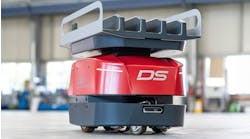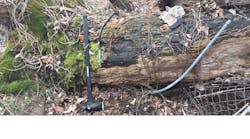The trunk of the thing was about 4-feet high and its roots dangled up even higher—a gigantic, decaying jungle gym I swore I'd remove as soon as we were settled in.
Last month, I decided it was finally time to take care of it.
Now, there was a clear and easy way to go about this: drive 7 miles down the road to rent a good chainsaw that's up for the task, bribe some friends with a few beers, and be done with the thing after a few short hours of lifting.
As the editor for an industrial equipment magazine, I should probably understand this better than many. For the past 81 years, this magazine has been covering one topic: you need the right tool to do the job right. We have written thousands of articles on this theme and published hundreds of thousands of products all trying to prove that same point.
So it should be clear to me by now: investing in the right tools saves time and money. That’s a proven truth both in my magazine and the industry I cover.
But I chose to go in a different direction. I decided to save a buck by using all the wrong tools instead.
So I went at the tree with a rusty handsaw I found in the garage and a dull 8-pound splitter I picked up for cheap at a hardware store slightly closer than the one that would have rented me a good chainsaw.
I figured the tree was probably half-rotten by now and all it really needed was a few chops.
I hacked, I sawed, I chopped, I cussed. Neighbors pulled out lawn chairs to watch me go at it and yelled out "helpful" suggestions along the way—the same thing they do when I drag around my giant extension cord for my electric mower.
Six hours later, there was almost no sign that I had done any work at all. No sign, that is, but the sweat, scratches, and poison oak I was completely covered with. (I've written a dozen articles about PPE in my career here, but I didn't follow that advice either. Short sleeves, short pants, lots and lots of poison oak.)
Finally, I admitted that this tactic wasn't working and went to get myself a chainsaw. But, to save a buck again, I decided to invest in the cheapest chainsaw the industry has ever produced—a 12-inch electric with all the power of a hedge clipper.
Now, for the past three weekends, I’ve been out there with that toy tool for at least five hours a day, hacking, sawing, cussing.
After nearly 40 hours of work, I’d say I’m 75% done with the project. With (another) fresh chain this weekend, I should finally be done.
At this point, I realize it's probably time to check that old “right tool for the job” premise.
So here's my tally:
- Axe: $20
- Chainsaw: $50
- Chains: $35
- Every single poison oak remedy on the market: $40
- Total: $145
The cost of a 1-day rental for a full-powered 20-in. chain saw that seemed too expensive to consider at the start? $65.
And there we are. My attempt to save a buck cost me $80 and a month of weekends with the family while providing me with nothing but a sore back and itchy arms.
So I’d say the premise is sound and the jerk neighbors are right: work smart, work safe, use the right tools.
That’s the same principle that keeps manufacturing running lean, the same principle that keeps NED relevant, and a principle I think we all need to incorporate more fully into our lives. Or at least I do.











